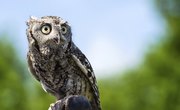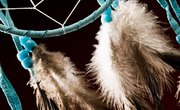The Cherokee are one of the best known, oldest and largest Indian tribes in the United States. The Cherokee learned to cultivate corn around 1,000 B.C. Centuries later, they shared their agricultural knowledge with European settlers in America. The Cherokee once occupied land from the Great Lakes to the southeastern part of the U.S. In the 1800s, President Andrew Jackson forcibly relocated the Cherokee to Oklahoma. Thousands of lives were lost to disease and starvation in the long resettlement march known as the Trail of Tears. Through it all, the Cherokee remained strong and resilient.
Today, the sovereign Cherokee Nation keeps native history, language and culture alive. Symbols, signs and stories play a key role in transmitting cultural values, ideas and norms from one generation to the next. Cherokee beliefs are steeped in religion, spirituality and ancient lore about animals and birds, particularly the eagle, owl and buzzard.
Tip
While owls are respected for their role in the Cherokee creation story, they are also feared because only medicine men can tell the difference between a real owl and an evil witch in an owl disguise.
Traditional Cherokee Beliefs
Traditional ways and beliefs hold a place in everyday life for many Cherokee Indians. Order is valued, and certain numbers hold special meaning. For example, the number four represents the cardinal directions: east, west, north and south. The number seven is associated with the seven dimensions of the world: upper world, center and lower world, plus the four compass directions. Spirit animals like the owl can transverse the upper world and the center inhabited by man. There are seven Cherokee clans of families that follow a maternal line of kinship descent. Marriage within a clan is not allowed.
Traditional Cherokee people respect the owl and the cougar because they were the only animals able to stay awake and look after the Earth during the seven days of creation. Cedar wood is also considered sacred because cedar retained its red and green color during the creation instead of turning brown like other types of wood. Upon death, the bodies of revered Cherokee leaders were traditionally carried on cedar wood in tribute to their legacy.
Medicine men and women have always played an important role in Cherokee society. Only members of the Cherokee Nation are permitted to seek assistance for medical, personal or spiritual concerns from a medicine man or woman. Ceremonies, divination and healing practices are passed down through oral tradition and in sacred books. Cherokee healers may turn to the owl for guidance.
Traditional Cherokees firmly believed that good deeds are rewarded, and evil acts are punished. When the natural order is upset, and awful things happen to good people, the cause is attributed to a bad person or a witch using bad medicine to cause trouble. A medicine man or woman must be called upon to intervene, often aided by a spirit animal such as the owl. Like many Indian tribes, the Cherokee believe in ghosts and a spirit world. When people die, their soul continues to exist in spirit form. The Cherokee take care to avoid contact with the little people, who are spiritual beings dwelling in mountain caves and dense thickets. Little people are invisible most of the time.
Owls in Native American Culture
The symbolism of the owl varies considerably by tribe. Some Native American tribes view the owl as an unwelcome creature of the night. Seeing or hearing a screech owl nearby is a bad omen, especially in broad daylight. The eerie hooting sounds and horn-like feather tufts of the great horned owl and the screech owl frightened many tribes who associated owls with the underworld.
The Passamaquoddy share stories of owls bewitching people with love medicine and magic flutes that would cause an Indian maiden to fall in love with the great horned owl. Witches were said to shape shift into the form of an owl for the purpose of spying on people and placing curses under cover of night.
Pacific Northwest Indians respected and honored the owl, as suggested by owl clan names and owl carvings on totem poles. Understandably, the Cheyenne and the Plains Indians appreciated short-eared owls that ate snakes. Owl feathers were worn by Cheyenne warriors to tap the owl’s power of night vision and stealth. Medicine men and healers have traditionally held the owl in high regard. Only they could distinguish between a real owl and an embodied witch or evil spirit. Real owls were considered wise and gentle birds.
Cherokee Owl Meaning
Traditional Cherokee Indians are leery of many owls. They believe that evil spirits, ghosts and witches can appear in the body of an owl. In the Cherokee language, the word "skili" can mean witch or great horned owl. Children were warned that if they cried too loudly, they might be swept away in the talons of a great horned owl. Cherokee warriors wore owl skins and feathers when scouting for enemies and hooted like owls to frighten off foes. War parties heading to battle carefully listened for the sound of screech owls, believed to foretell death and defeat.
The owl had a very different meaning for indigenous tribes of the Northwest. The owl was considered benevolent. The Tlingit and the Haida tribe carved totem poles that included an owl symbol. Tribal totem poles represented the spirit animals that looked after that particular tribe.
Cherokee Owl Legends
Animals and birds are often the main characters in Cherokee lore. Two Cherokee legends tell the story of the owl falling in love. One tale ends well for the owl, while the other does not. According to the legend of “Why the Owl Has a Spotted Coat,” an owl stood in the shadows while visiting his future in-laws, fearing that they would not permit him to marry their daughter if they saw his ugly face. The girl’s brothers wondered why the owl was hiding and built a blazing fire to get a good look at him. To hide his face, the owl raised a wing and turned. Hot embers burned spots on the owl’s back that are still visible today. Despite the ordeal, the couple married and presumably lived happily ever after.
“The Owl Gets Married” is the Cherokee legend of an owl who turned himself into a man in search of a bride. He successfully persuaded a young woman’s mother that his hunting skills would make him an excellent husband. His wife became suspicious when he failed to catch anything other than small fish and lizards. She followed her husband on his next hunting expedition, where she saw him turn into an owl. She threw him out when he returned home. The owl wandered off into the woods and wasted away, pining for his lost love.
Do Owls Represent Death?
Death and illness are commonly associated with the sight or sound of an owl in many Native American cultures. Aztecs and Mayans thought that owls kept company with the gods of death. Owls were also said to carry warnings and messages from the dead to the living. The presence of an owl outside an ill person’s bed was considered a harbinger of impending death. In the Pacific Northwest, owls were said to call out the names of those who were going to die soon.
The Sioux believed that owls guarded the gates of the afterworld. The soul of the departed would stand in judgment before the owls, who decided whether to direct the soul into the spirit world or the eternal abyss. In the Ojibwa culture, the owl foretold death or bad luck. The Pueblo Indians associated the owl with Skeleton Man, a god who had power over death and fertility. Owls were also thought to steal souls and work through bad medicine men to sicken and kill the owl’s enemies.
However, some tribes see the owl as a good omen. The owl brings wisdom and knowledge. The owl also represents a protective spirit for warriors of the Dakota Hiatsa tribe. Delaware Indians believed that dreaming of an owl brings protection.
Related Articles
References
- PowWows.com: Concerning Owls
- First People: The Owl Gets Married
- First People: Why the Owl Has a Spotted Coat
- Buffalo Bill Center of the West: Owls in the Native American Culture
- Exemplore: Owl Symbolism – What Does It Mean When You See an Owl?
- Indians.org: Cherokee Indians
- warpaths2peacepipes.com: Totem Pole Symbols and Meanings
Writer Bio
Dr. Mary Dowd is a dean of students whose job includes student conduct, leading the behavioral consultation team, crisis response, retention and the working with the veterans resource center. She enjoys helping parents and students solve problems through advising, teaching and writing online articles that appear on many sites. Dr. Dowd also contributes to scholarly books and journal articles.










